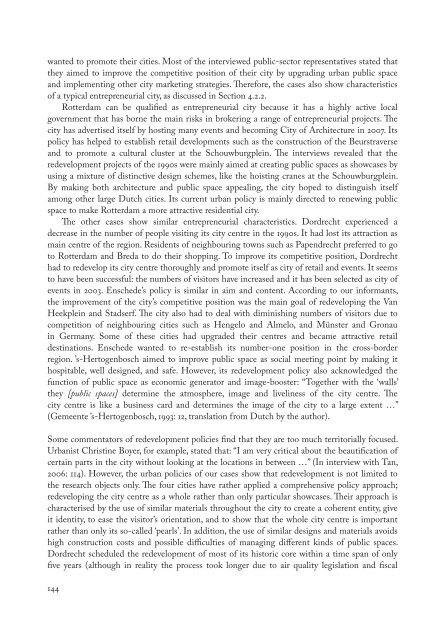Changing public space
Changing public space
Changing public space
Create successful ePaper yourself
Turn your PDF publications into a flip-book with our unique Google optimized e-Paper software.
wanted to promote their cities. Most of the interviewed <strong>public</strong>-sector representatives stated that<br />
they aimed to improve the competitive position of their city by upgrading urban <strong>public</strong> <strong>space</strong><br />
and implementing other city marketing strategies. Therefore, the cases also show characteristics<br />
of a typical entrepreneurial city, as discussed in Section 4.2.2.<br />
Rotterdam can be qualified as entrepreneurial city because it has a highly active local<br />
government that has borne the main risks in brokering a range of entrepreneurial projects. The<br />
city has advertised itself by hosting many events and becoming City of Architecture in 2007. Its<br />
policy has helped to establish retail developments such as the construction of the Beurstraverse<br />
and to promote a cultural cluster at the Schouwburgplein. The interviews revealed that the<br />
redevelopment projects of the 1990s were mainly aimed at creating <strong>public</strong> <strong>space</strong>s as showcases by<br />
using a mixture of distinctive design schemes, like the hoisting cranes at the Schouwburgplein.<br />
By making both architecture and <strong>public</strong> <strong>space</strong> appealing, the city hoped to distinguish itself<br />
among other large Dutch cities. Its current urban policy is mainly directed to renewing <strong>public</strong><br />
<strong>space</strong> to make Rotterdam a more attractive residential city.<br />
The other cases show similar entrepreneurial characteristics. Dordrecht experienced a<br />
decrease in the number of people visiting its city centre in the 1990s. It had lost its attraction as<br />
main centre of the region. Residents of neighbouring towns such as Papendrecht preferred to go<br />
to Rotterdam and Breda to do their shopping. To improve its competitive position, Dordrecht<br />
had to redevelop its city centre thoroughly and promote itself as city of retail and events. It seems<br />
to have been successful: the numbers of visitors have increased and it has been selected as city of<br />
events in 2003. Enschede’s policy is similar in aim and content. According to our informants,<br />
the improvement of the city’s competitive position was the main goal of redeveloping the Van<br />
Heekplein and Stadserf. The city also had to deal with diminishing numbers of visitors due to<br />
competition of neighbouring cities such as Hengelo and Almelo, and Münster and Gronau<br />
in Germany. Some of these cities had upgraded their centres and became attractive retail<br />
destinations. Enschede wanted to re-establish its number-one position in the cross-border<br />
region. ’s-Hertogenbosch aimed to improve <strong>public</strong> <strong>space</strong> as social meeting point by making it<br />
hospitable, well designed, and safe. However, its redevelopment policy also acknowledged the<br />
function of <strong>public</strong> <strong>space</strong> as economic generator and image-booster: “Together with the ‘walls’<br />
they [<strong>public</strong> <strong>space</strong>s] determine the atmosphere, image and liveliness of the city centre. The<br />
city centre is like a business card and determines the image of the city to a large extent …”<br />
(Gemeente ’s-Hertogenbosch, 1993: 12, translation from Dutch by the author).<br />
Some commentators of redevelopment policies find that they are too much territorially focused.<br />
Urbanist Christine Boyer, for example, stated that: “I am very critical about the beautification of<br />
certain parts in the city without looking at the locations in between …” (In interview with Tan,<br />
2006: 114). However, the urban policies of our cases show that redevelopment is not limited to<br />
the research objects only. The four cities have rather applied a comprehensive policy approach;<br />
redeveloping the city centre as a whole rather than only particular showcases. Their approach is<br />
characterised by the use of similar materials throughout the city to create a coherent entity, give<br />
it identity, to ease the visitor’s orientation, and to show that the whole city centre is important<br />
rather than only its so-called ‘pearls’. In addition, the use of similar designs and materials avoids<br />
high construction costs and possible difficulties of managing different kinds of <strong>public</strong> <strong>space</strong>s.<br />
Dordrecht scheduled the redevelopment of most of its historic core within a time span of only<br />
five years (although in reality the process took longer due to air quality legislation and fiscal<br />
144




